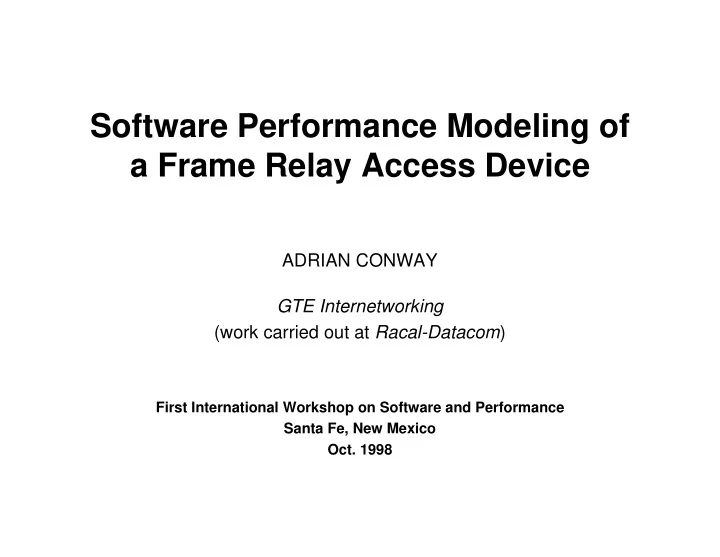

Software Performance Modeling of a Frame Relay Access Device ADRIAN CONWAY GTE Internetworking (work carried out at Racal-Datacom ) First International Workshop on Software and Performance Santa Fe, New Mexico Oct. 1998
Frame Relay Network Access Device FRAD FRAD • Frame Relay Network – virtual-circuit service frame relay – connects remote sites network – economical compared to a private leased-line network • FRAD – interconnects LANs and DTEs to FRAD the frame relay network – a multi-protocol multi-function ethernet DTE device DTE token ring
Racal’s FastFrame 600 FRAD Protocol Architecture ALC UDP mux SNA IP protocols SDLC LLC ALC protocol PPP Frame Relay mux mux token BiSync sync sync/asynch Ethernet ring drivers drivers drivers driver driver user user user WAN user user token Ethernet ring
FastFrame 600 FRAD Software • Protocol Modules – standardized • acquired from various vendors – proprietary • different software development groups • Protocol Integration with UNIX STREAMS Facilities – kernel routines for layered protocol software – modular architecture • drivers, modules, multiplexors, queues – simplifies development – reduces development time
Need for Software Performance Modeling and Analysis • protocol modules developed by different groups • performance of integrated system is unknown a priori – throughput, delay, burst handling • shortened time to market – less time for performance measurement, re-design, tuning • performance ‘disasters’ at end of development cycle are costly • real-time performance is of increasing importance (e.g. voice/packet) • product requirements include performance • need UP-FRONT analysis at product specification phase – architectural choices, verify design for performance requirements, expose potential flaws • analysis at testing stage – tool to help in parameter optimization – evaluate ‘last-minute’ changes
FRAD Performance Modeling and Analysis • We propose a software performance model for data- networking products based on STREAMS • UNIX STREAMS maps naturally into a queueing model – model focuses on data-transfer phase – exploit structure imposed by STREAMS • service times (path-lengths) obtained from code measurements • analysis using simulation or analytical techniques
STREAMS Modeling user user user space process process stream stream head head Multiplexor kernel space module module driver driver hardware
messages (packets) queues in a module queues in a multiplexor
• Message priorities in a STREAMS queue – normal messages – expedited messages (levels 1 to 255) – high-priority messages – FIFO scheduling within each priority band • Message passing from one queue to another in STREAMS – involves kernel routines • putnext ( ) • put ( ) • putq ( ) • service ( )
queue A queue B (1) queue A service (3) queue B put calls putnext processes message (2) putnext passes (4) put passes message to queue B put message to putq (5) putq places message on queue B (6) putq schedules queue B service
• Scheduling of Service Routines by STREAMS – service routines called by STREAMS scheduler – STREAMS scheduler is FIFO – STREAMS scheduler processes all messages on a queue when service routine is called • Inter-Queue Flow Control in STREAMS – counter q_count – high and low water marks – service routines “put to sleep” if flow control in force – service routines “woken up” when flow control removed
State-Dependent FIFO Queueing Model service routines STREAMS scheduler data traffic creation of service state of routines STREAMS queues
Model Analysis • Analytical – difficult due to complex state-dependencies – possible to develop a simplified Markov chain model – a challenging performance analysis problem • Simulation – simulation model implemented using OPNET Modeler – could automate building of OPNET model using OPNET EMA interface
Concluding Remarks • Software performance modeling and analysis is an essential for data-networking product development • research needed for SPE of data-networking products • automated tools are needed for SPE • we proposed a queueing model for SPE of STREAMS-based data-networking products
Recommend
More recommend